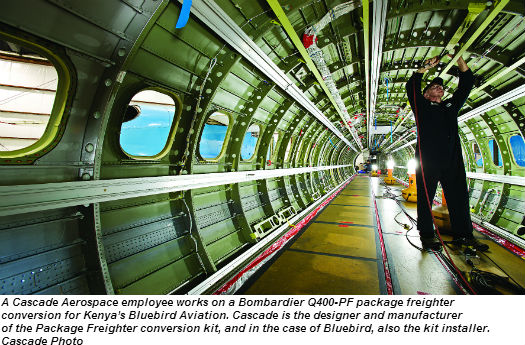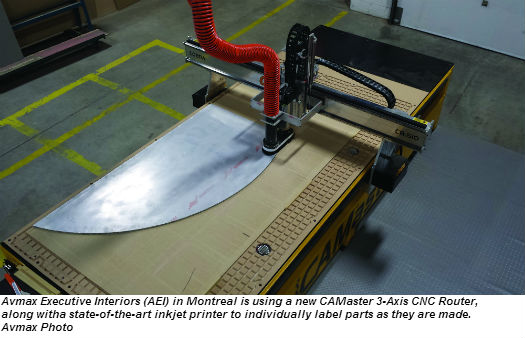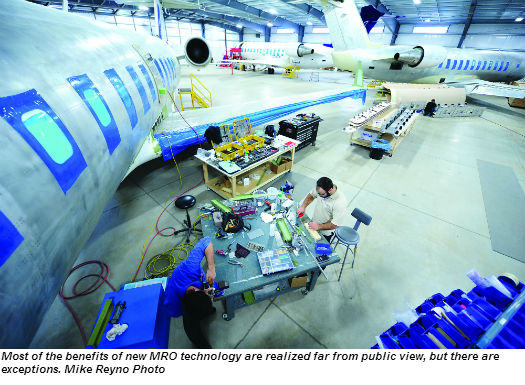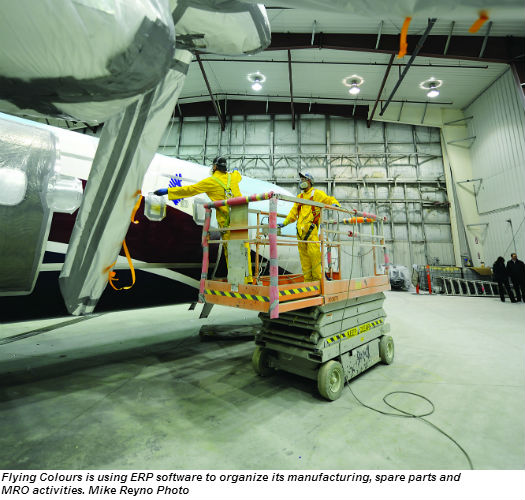The aircraft maintenance, repair and overhaul (MRO) business is technical by definition, so it will come as no surprise that new technology is slowly but surely making its way into the hangar.
Recently, Canadian Skies asked MRO providers across the country how they are using new software, hardware and handheld devices to transform the way they do business.
The answers provide insight into how new technology is leading to innovation and change in the Canadian MRO service sector, which is estimated to be worth a whopping $3.3 billion per year (excluding MRO activity performed by manufacturers and airlines).
Accelerated Maintenance
Most of the benefits of new MRO technology are realized far from public view, but there are exceptions.
At the NATO Flying Training in Canada (NFTC) Program at 15 Wing Moose Jaw, Sask., 24 turboprop Beechcraft CT-156 Harvard II trainers provide each Canadian and international student pilot with 76 hours of ab initio flight training, and 91 hours of more advanced pre-wings flight training.
When Bombardier Aerospace commenced the 20-year NFTC contract in May 1998, a key requirement was to have an electronic fleet management system to allow efficient turnaround times of the 17 Harvard IIs, which had to fly a total of 85 sorties a day in five waves.
“The only way Bombardier could contractually meet this aggressive utilization target was to introduce a ‘pit crew’ maintenance philosophy on the flight line, and a paperless electronic fleet management system (EFMS) to manage all aircraft maintenance and flight line release activities,” explained Angela Oddo, director of programs and business operations at Bombardier Military Aviation Training at 15 Wing in Moose Jaw.
“We launched the NFTC program with the goal of turning 17 CT-156 aircraft in 12 minutes. Using a paper-based system it would be difficult to turn an aircraft in less than 15 minutes.”
Upon landing, the Harvard IIs are met by a Bombardier service crew, who refuel the aircraft and do all the maintenance checks. All the flight and aircraft data is immediately entered using four laptop computers installed in the line van (a modified minibus), and wirelessly transmitted in real time to the NFTC aircraft servicing desk in the hangar.
Aircraft release and acceptance is handled electronically at the servicing desk, where pilots inspect the online maintenance records and sign for their aircraft using an electronic signature.
“The system has been upgraded three times and we are now in our fourth release,” said Oddo. “Introducing a software upgrade to this system is challenging because the project management 80/20 rule does not apply. With a real time electronic airworthiness record system, you need to be 100 per cent accurate before you go live.”
The system upgrades have helped NFTC cut the turn time for a Harvard II to an impressive six minutes. In October 2013, the NFTC program celebrated 200,000 flying hours on its Harvard II fleet, a total reached in just 13 years since the program began in 2000.
Software, hardware and the digital hangar
Today’s new aircraft maintenance engineers and technicians are members of Generation Y, the Millennials who grew up in a digital world of mobile devices and thousands of downloadable apps.
In Quebec, the École nationale d’aérotechnique (ENA) at St. Hubert Airport offers three programs in aerospace technology – Technical Aircraft Maintenance, Technical Avionics, and Aircraft Construction Techniques – and is affiliated with the CEGEP Édouard-Montpetit, one of the biggest colleges in Quebec.
The ENA avionics labs are some of the best equipped in Canada, with graduates finding immediate work on the local Bombardier and Bell helicopter aircraft production lines, and across the Quebec MRO industry.
“About five years ago, ENA revised its avionics program and we received about $5 million to invest in state-of-the art avionics systems, and test and calibration equipment for the labs,” said Raymond Gosselin, a senior ENA avionics instructor. “Our shopping list included traffic collision avoidance systems (TCAS), weather radar, Stormscope weather tracking and automatic dependent surveillance – broadcast (ADS-B) systems; and test equipment for distance measuring equipment (DME), transponders, TCAS and a lot more.”
Along with these systems, ENA students also use Apple iPads in the hangar to consult course notes, manuals and regulatory documents.
Besides new hardware, Canadian MRO providers have been making major investments in enterprise resource planning (ERP) software systems, which allow for the better management of work processes, as well as a clearer overall picture of all aspects of the business. Some companies buy popular systems widely used for small and medium size organizations, and customize them for MRO use. Other companies have purchased ERP systems from aviation software providers, which are already built for MRO applications. And a handful of MRO companies, with strong IT departments, have developed ERP systems largely on their own.
Over the past five years, Vector Aerospace Engine Services – Atlantic (ES-A) has been very busy introducing new technologies into its MRO business. ES-A began in 1991 as Atlantic Turbines. Today, the company employs 540 people at its headquarters in Summerside, PEI (which processes about 20 engines a week), and other facilities in North America, South Africa, Kenya and Australia.
“Having custom-built ERP software provides a competitive edge in the MRO market, where our software can conform to our process and then the reverse,” said Jeff Poirier, ES-A president.
ES-A has been working hard to refine its custom-built ERP application, moving away from the “server/dumb terminal” format to a richer graphic user interface (GUI) web-based solution, leveraging new Microsoft coding technologies to enhance and tighten its software.
In its engine shop, ES-A now employs an automated pulse water jet stripping system (APWJSS), which uses a relatively low water pressure, combined with an induced ultrasonic pulse, to efficiently remove various aircraft coatings.
The company has also implemented a radio frequency identification (RFID) system to track engine components through the repair process in real time.
This system uses passive RFID technology, which places a small RFID tag on each component undergoing repair. As the component travels through the facility, the tag is read as it passes through defined checkpoints.
“The RFID information is integrated with our ERP system, to compare the planned part location with the actual part location,” said Poirier. “Among the many benefits is our ability to monitor component location in real time to ensure that the component repair process is completed on time for our customer.”
The company has also implemented an RFID tooling verification system on its multi-axis computer numerical control (CNC) machine. Each tool assembly has a durable RFID chip embedded in it, and each machine tool location and cabinet location also has an RFID tag.
“The major benefit of this system is that it virtually eliminates the possibility of the wrong tool assembly being used for a particular CNC program, which can be extremely costly,” explained Poirier. “This mistake-proofing system has the potential to save us a substantial amount; several times over the cost of implementing the solution.”
Meanwhile, in Peterborough, Ont., Flying Colours Corp. has also been implementing ERP software.
“We weighed the various options and decided to introduce the Corridor ERP system (developed by Continuum Applied Technology), which was already in use at our U.S. facility,” said Glenn Williams, the company’s director of maintenance.
“We introduced the Corridor in Canada in March 2013, and are now using it to organize our manufacturing, spare parts and MRO activities, including manpower, task cards, logbook entries and invoicing.
“We are moving towards a paperless system utilizing electronic task cards, forms and manuals, but we still have to sign and scan documents because Transport Canada doesn’t currently accept electronic signatures,” explained Williams.
With the shift to a new ERP platform, Flying Colours has now introduced iPads in its hangars to replace paper task cards and the swiping of bar-coded cards.
“Today, we also use Skype to call our aircraft maintenance engineers (AMEs) in the field, and they often walk us through a job using live video feed from their mobile phone,” added Williams.
Out in Abbotsford, B.C., Cascade Aerospace is performing MRO work for both military and civilian clients. About 60 per cent of Cascade’s business is maintaining military Lockheed C-130H/J Hercules aircraft, with the balance including diverse work packages such as a Canadair CL-215T turbine conversion, a Bombardier Q400 package freighter conversion, and heavy maintenance on Boeing 737-200C combi aircraft.
A couple of years ago, Cascade began the process of selecting an integrated ERP system to replace “an outdated and unstable system that cobbled together 57 applications,” said Stuart McIntosh, Cascade’s vice president of operations.
“We needed an ERP system that was flexible enough to support MRO work on modern military aircraft, as well as on older aircraft that can be a drag on the implementation of new technology.”
Cascade selected the Epicor 9 next-generation ERP solution, and customized it for MRO use.
“We’re now about six or seven months into the (ERP) journey and have learned that ERP technology is only as good as the processes you have in place,” commented McIntosh.
“That’s one reason why we’ve adopted lean management techniques to make our processes more efficient and eliminate waste.
“Our employees have a varied skill set and different aircraft type endorsements, and the new ERP system helps us have the right people at the right aircraft at the right time.”
Cascade has the technology to go “paperless” but some of its civil and military customers still require paper documentation.
Managing multiple data sets
For many Canadian MRO facilities, the ability to assemble and evaluate data from multiple locations was a critical business requirement. For example, the Calgary, Alta.- based Avmax Group employs 775 people at more than half a dozen locations.
A decade ago, Avmax began to diversify with the establishment of a leasing company and airline (Regional 1 Airlines), and then three international MRO facilities in Great Falls, Mont., Jacksonville, Fla., and Gabon, Africa.
“We ended up with multiple business units in multiple locations, supported by multiple software systems and a lot of old Excel worksheets,” said Al Young, vice president of operations. “It wasn’t easy to obtain good visibility of our overall business and manage it as a whole.
“We required an ERP system that could integrate multiple businesses and sites, and cover everything from quotes to invoicing, and track all our work orders, inventory and maintenance tasks.”
Avmax selected Quantum Control ERP system, developed by Component Control of San Diego, Calif.
“We are now starting to see the advantages of the new ERP system across our business, but a lot of back end work was required,” said Young.
Added his colleague, Avmax planning manager Paul Draper: “My role is to see that the work scope from the client is turned into a work package that goes out on the (hangar) floor, and we get the job done right. With the ERP system, everybody has insight as to what is happening with a project. The accountants can see what’s happening from a financial perspective, and we’re able to accurately set up the pre-draw of all the parts we require,” he continued. “The integration within the ERP system takes the human factor out of the equation.”
Avmax also uses its new ERP software to help manage its large aircraft leasing fleet of about 120 regional aircraft, including 72 Bombardier Dash 8 turboprops and 44 CRJ regional jets.
Meanwhile, in a suburb of Montreal, Avmax Executive Interiors is using different technology to produce two to three large corporate jet interiors a year, according to general manager Bob Donnelly.
“We introduced SolidWorks 3D CAD software to help customers visualize an aircraft interior. Or, it can go much further and quickly cut a sample sidewall or cabinet panel to present to the customer for approval, by utilizing VCarve Pro CAM Software to run a CNC router,” explained Donnelly.
Technology and the SME
Small and medium-sized enterprises (SMEs) that support the Canadian MRO industry are also using technology to streamline production and increase efficiency.
Mississauga, Ont.-based Precision Aero Components is a small company whose 13 employees work on electrical, hydraulic and other components used on turbine aircraft, ranging in size from Beech King Airs to Boeing 767s.
“We’re starting to look at 3-D printing (also known as additive manufacturing) to help us obtain repair design approval (RDA) for components,” said Tony Di Vincenzo, company president.
Today’s 3-D printers used in manufacturing create a part – one thin layer at a time – using powdered metal, plastic or other material, in a machine that resembles a large office printer.
“We foresee using this technology as part of a step-by-step process where we can create a model of a component, which we can use to develop different kinds of repairs,” added Di Vincenzo.
Harold Hope recently came out of retirement to help his family-owned propeller business, Hope Aero, move to a new location near Toronto’s Lester B. Pearson International Airport.
Hope said the biggest technological change he’s seen is the introduction of composite propellers, as well as his firm’s acquisition of an Aeroscan computer-controlled propeller blade measuring system. The unit automatically checks five key propeller parameters simultaneously, including blade thickness, width, angle, edge alignment and face alignment.
“That machine has replaced the Vernier calipers and protractors we used in our business for decades,” said Hope.
Whether large or small, it’s clear that Canadian MRO organizations – and the SMEs that support them – are moving to increase the level of technology on the shop floor. The latest maintenance-focused hardware and software has been designed to simplify processes while reducing the chance of human error. As productivity in the hangar rises, Canadian MROs are hoping that technology investments will pay for themselves, many times over.















